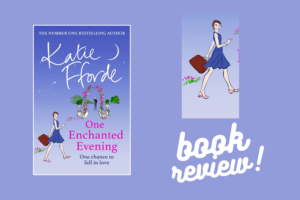
This feature is in association with NetGalley.
One Enchanted Evening by Katie Fforde
Many thanks to NetGalley and to Random House UK, Cornerstone, Century for letting me see an advance reader’s copy of One Enchanted Evening.
This is the first time I’ve ever read anything by Katie Fforde, although I am of course familiar with the name and the kind of books she writes.
This story is about Meg, who answers an SOS from her mother deep in the Dorset countryside trying to make a success of her latest business venture. The new chef has sacked everyone and Louise, Meg’s mother, needs her daughter’s help, and she needs it NOW.
Although predictable, it is after all a ‘feel good’ romance novel, it is very well written. I loved the setting in Dorset and when I thought it a tad old-fashioned, I remembered it was set in the 1960s. I thought some of the characters were lovely, such as the elderly and mysterious Ambrosine, and I even enjoyed the stereoptypes too, who I think were written a bit tongue-in-cheek.
The last few chapters seemed a bit unedited. They chopped around with oddments of text that I think should have gone somewhere else, and they felt a bit rushed. But my biggest bugbear was the number of characters in the story, and particularly when another boatload turned up for the finale/closing image.
There were loads and loads and loads of characters, many of whom shared the same initial (Andrew, Alexandra, Amanda, Antoine and Ambrosine, all in the first chapter, then Laura, Letty, Lexi, Lizzie and Louise, and then Sally, Sam, Simon, Susan and Suzanne – really, Susan *and* Suzanne?), so that was confusing in itself. But I had a niggling feeling that I’d missed out on some of the characters’ histories and back stories… and then I discovered that there were at least two other books written previously about the same group of friends.
This really is a problem for me because it could have been mentioned that it was Book 3 in a series, even though it could and should be a standalone story – and the story does stand up very well by itself. Or it would if it didn’t fall down on the number of characters.
Some characters were only mentioned in passing and then given a name, as though for the sake of giving them a name (Clover?). One walk-on who didn’t say anything was randomly named Ted, and then we had Edward/Teddy mentioned later on who was a completely different but far more important person. At the end someone called Patsy suddenly featured quite importantly. Who is Patsy?
Much of this may be tidied up in editing, though, and it is a very well-written, nice story. Four stars.















